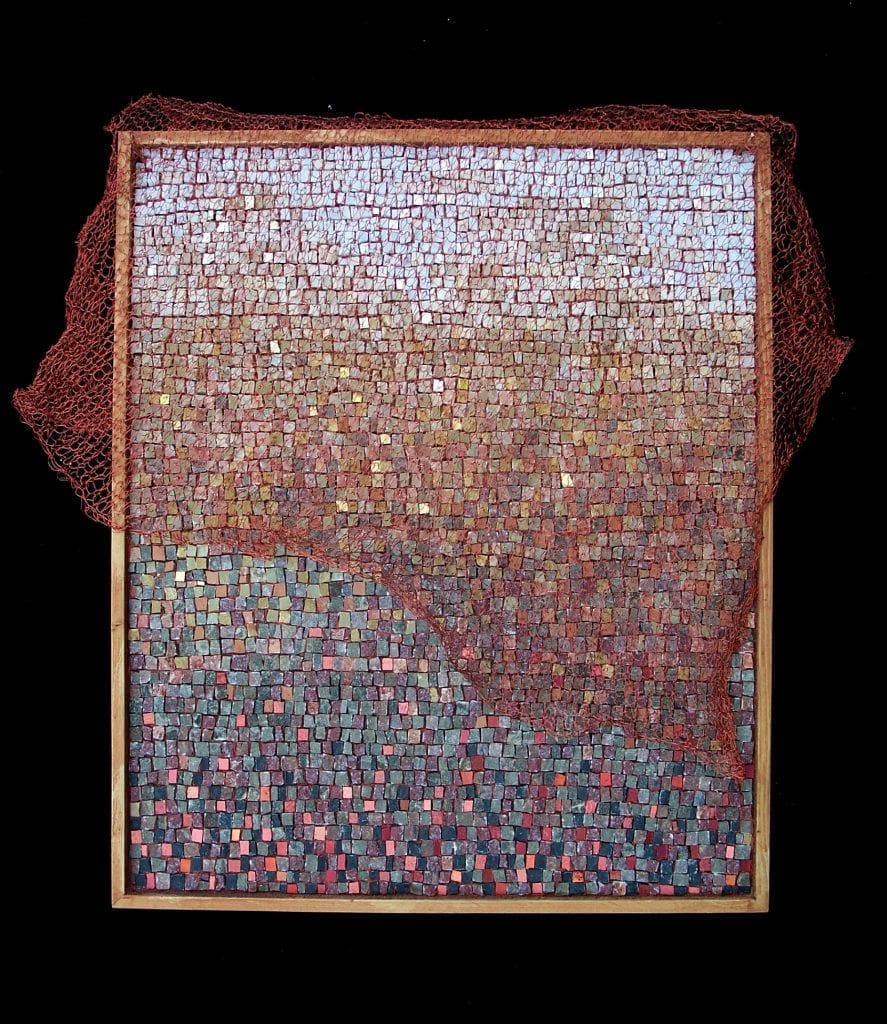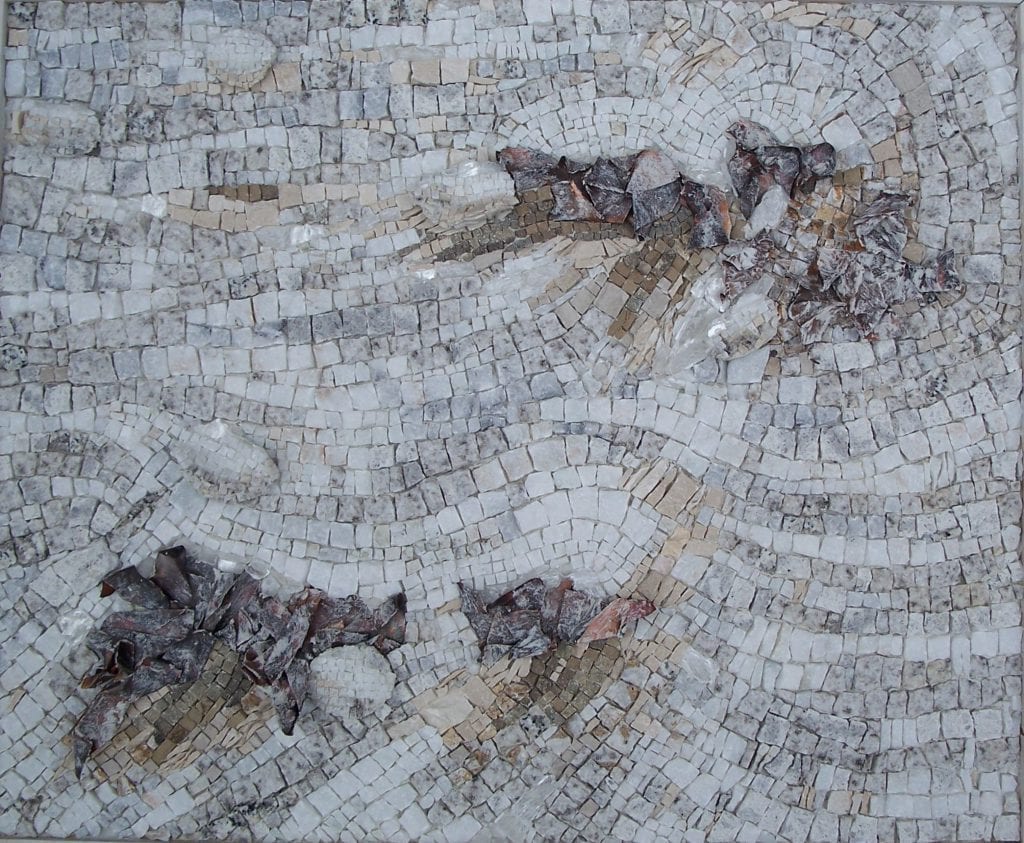
Sophie Drouin, “Exploitation”, 2014, Marble, stibnite, galena, glass, antique gold smalti, granite, magnetite, opal, tourmaline, moonstone
30″ (h) by 11.5″, 15″, and 18″ (w)
About the Behind the Mosaic Podcast Series
Behind the Mosaic Podcast: Episode 1 – Sophie Drouin
You can subscribe to the series on Soundcloud
Subscribe to the series on I-Tunes
Internationally recognized, award-winning mosaic artist Sophie Drouin is admired for her eclectic vision and artistic experimentation. She is a co-author along with the late Bill Buckingham of, ‘Listening to the Rocks’, a book detailing the properties of natural materials including jewels, as well as presenting display techniques and design concepts. Ms. Drouin is the English editor of the French publication ‘Mosaique Magazine‘ and has herself written numerous articles about exhibitions and fellow artists. She has also acted as professional translator for lectures by such artists as Verdiano Marzi. Her art has been featured in professional exhibits in Italy, France, the United States, and Canada. She has been commissioned for many mosaic installations, has performed as a juror in several important competitions, and has taught technique classes at all of the important mosaic studios in the U.S. and Canada.
Classically trained in Italy, France, and the United States, she is lauded for her innovative work in combining natural stone and marble materials with mosaic glass, in both traditional and modern styles. Her works include wall hangings, sculptures, window hangings in Dalles de Verres, and other uniquely textured and contoured techniques. One of her signature elements is the prolific use of copper in its many shapes and forms. As she is also a professional classical violinist, she incorporates her keen musical understanding and appreciation into many of her works.

Sophie Drouin, “Bullseye” (2009) Mosaic on framed plywood base Marble, gold smalti, stained glass, mirror, granite, terra cotta, glass, obsidian, copper wire and plate, raku pottery, quartz, selenite, calcite, opal, sandstone, slate 28″(h) by 36″(w) by 5″(d)

Sophie Drouin, “Evanescence” (2010) Mosaic sculptural modules on plywood base Marble, slate, tourmaline, gold smalti, glass, granite, stibnite, pyrite, terracotta 30″(h) by 24″(w) by 10.5″(d)

Sophie Drouin, “Scheherazade” (2012) Mosaic on framed plywood based on hand-knit copper wire veil. Marble, antique gold smalti, granite, terra cotta, hand-knit copper wire veil 15.5″(h) by 13″(w)

Sophie Drouin, “Roadside Slush” (2012) Mosaic on framed plywood base Marble, selenite, opal, granite, quartz, apophyllite, copper 18.5″ by 23″

Sophie Drouin, “Autumn Wind” (2013) Mosaic on framed plywood base Marble, travertine. granite, slate 20.5″(h) by 15.5″(w)

Sophie Drouin, “Spill” (2012) Mosaic on framed plywood base Marble, smalti, gold leaf, terra cotta, travertine, flint 21″(h) by 17″(w) by 3.5″(d)

Bernard Drouin, circa 1958-1959, Venice, Italy. Image courtesy of Sophie Drouin

Emilie and Sophie Drouin, 1962, Quebec City, Ontario, Canada. Image Courtesy of Sophie Drouin
References
Mosaic Arts International 2017
Glossary
Stone A broad category of rocks and minerals (including precious and semi-precious) that have properties such as color and hardness which can be used to advantage by mosaic artists. Stone is cut and shaped using hand or machine tools and the surfaces can be left in their natural state or polished smooth.
Igneous Stone formed from cooled magma or lava. This category includes granite and obsidian.
Metamorphic Stone formed when either igneous or sedimentary rock was exposed to high temperatures and pressure. Some examples are marble and slate.
Pebbles Small stones that are naturally smoothed by the movement of water or by human means such as by using rock tumblers.
Sedimentary Stones which are formed from layers of minerals that have been deposited over time. These are the rocks such as sandstone and limestone that can contain fossils.
Smalti Glass The plural of smalto, also known by some as enameled glass. This is glass, mostly opaque, in which metal oxides are mixed to give an extraordinary range of color. The molten glass is poured into disks, cooled, and cut into smaller rectangular pieces which he mosaicist will further shape by using tools such as a hammer. Smalti are typically laid with the cut sides face up to achieve the most brilliant effects. Historically, smalti come from Venice and Murano in Italy though today smalti are also made in Mexico. A more expensive variety of smalti are those that contain a thin layer of copper, gold, or silver leaf sandwiched beneath a thin layer of clear glass and a thicker glass base that may be clear or colored. Some mosaicists prefer the term “Venetian Gold” although, like the colored smalti, this material is now also produced in countries other than Italy.
Andamento From the Italian andare, “to walk or ride.” Describes the placement of tesserae in a flowing pattern that suggests movement among the elements of the composition.

